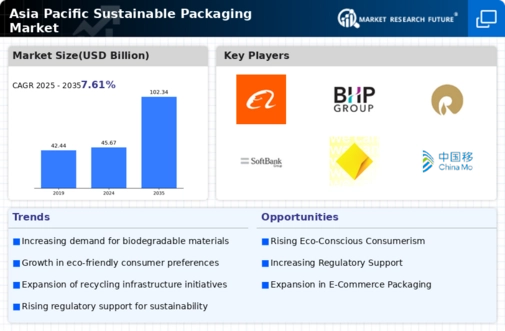Market Trends
Key Emerging Trends in the Asia Pacific Sustainable Packaging Market
There have been remarkable trends in the Asia Pacific Sustainable Packaging Market which express environmental consciousness and sustainable practices that the region is now emphasizing more. This has led to an increase in demand for sustainable packaging solutions since consumer awareness has gone up. In this respect, organizations operating in Asia Pacific are being compelled to embrace sustainable packaging as people move towards eco-friendly products like those packaged using recyclable materials, biodegradable ones, or renewable resources.
Government initiatives and regulations have been critical in shaping the market trends of sustainable packaging in Asia Pacific. Many countries within this region have adopted various policies with regard to reducing plastic waste, promoting recycling as well as encouraging use of sustainable materials in their respective packaging sectors. Their implementation and incentives to firms that embrace sustainability on the other hand has forced firms to adopt eco-friendly ways of packaging aiming at meeting environment standards while having their eye on reducing environmental impact caused by packaging.
Moreover, there is a rise in innovation among companies operating within the Asia Pacific Sustainable Packaging Market looking for emerging new materials as well as technologies. Creative ideas are being born out of these such as biobased plastics, compostable materials and advanced recycling techniques which constitute alternatives to conventional packages hence they can be termed as sustainable. The challenge is creating packages that do not harm nature but still meet customer’s requirements therefore driving forward change and innovations within this industry.
Furthermore, one major factor driving sustainability packaging trends is e-commerce boom across countries in Asia-Pacific. This is due to the fact that online shopping industry keeps growing necessitating package designs that protect goods while supporting sustanability. E-commerce providers are searching for containers which can minimize wastage by enabling reusing certain components or shrinking size so as not add much on carbon emanated from transportation.
Packaging waste reduction initiatives are gaining traction with many companies committing towards achieving circular economy goals across Asia Pacific region. This means that packages can be easily recycled or reused thus reducing the overall carbon footprint. Therefore, the packaging industry is moving towards a closed-loop system where materials are either reutilized or reintegrated back into the production hence this will foster more sustainable packaging.
Partnerships and collaborations are now key trends in the whole supply chain in Asia Pacific Sustainable Packaging Market. Firms have realized that for sustainability to be all inclusive, there is need for partnership among suppliers, manufacturers and retailers with a broader approach. These initiatives are aimed at improving recycling infrastructure, developing more environmentally friendly packaging alternatives and achieving collective change across sectors towards shared environmental goals.
However, issues such as cost considerations and infrastructural development continue to hinder progress for the Asia-Pacific Sustainable Packaging Market. While popularity of these environment-friendly material and technology is growing they may sometimes be more expensive than their conventional counterparts. The challenge lies on how businesses can attain economic feasibility of implementing sustainable packaging solutions without overlooking environmental benefits associated with them. Moreover, there should be increased investment in waste management systems coupled with improved recycling infrastructure so as to ensure proper disposal of these environmental-friendly materials through recycling processes.

















Leave a Comment